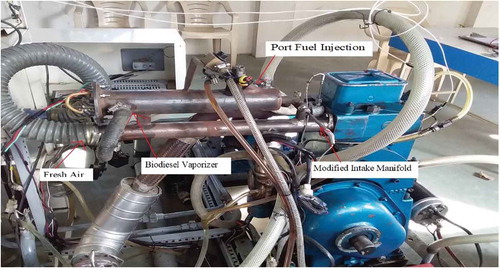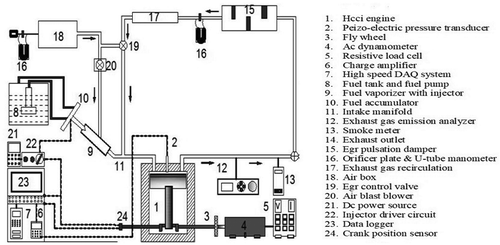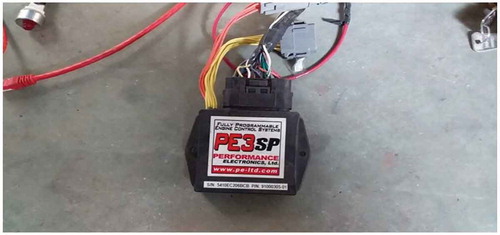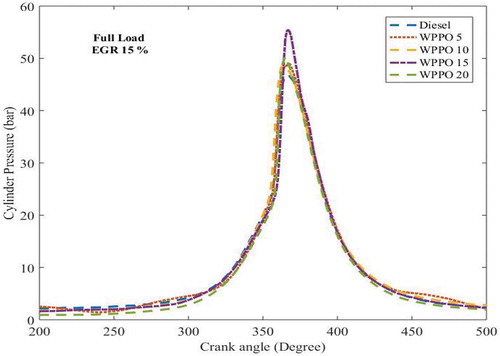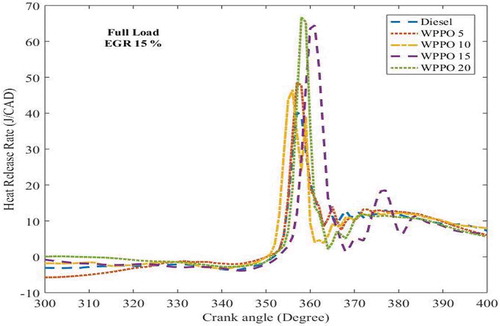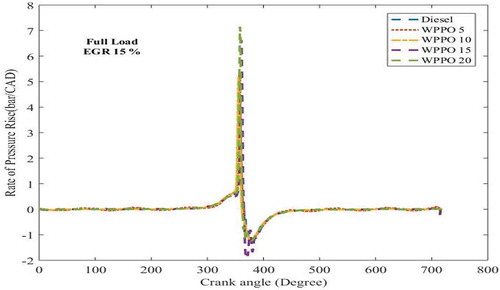ABSTRACT
Analysis of plastic oil obtained from waste plastic through pyrolysis process, as an alternative to biodiesel is presented in this paper. The HCCI engine is considered for experimental validation of combustion performance and emission characteristics. To accumulate pyrolysis oil as fuel, the design modifications were made in external mixture formation on the existing computerised 4-stroke, single cylinder, water cooled, direct injection kirloskar diesel engine connected with eddy current dynamometer to satisfy HCCI conditions. HCCI engine can be worked on wide assortment of fuels beginning from diesel to different blends (WPPO 5%,10%,15% and 20% by volume) of biodiesel .The designed additional device connected to the engine is utilised for fuel vaporisation and mixture arrangement. In the experimental study, the combustion results were initiate to be of 39.69 % higher Rate of Heat Release (RoHR) for biodiesel HCCI as compared with diesel HCCI. Higher brake thermal efficiency (BTE) was found 37 % without exhaust gas recirculation (EGR) at WPPO 20 % biodiesel blend. And also found 50 % and 65 % reduction in NOx emission and 18 % and 28 % reduction in smoke opacity are obtained for biodiesel vapour induction without EGR and biodiesel vapour induction with 15 % EGR as compared with diesel fuel. The CO (0.34 %), and UHC (2.15 %) emissions are increases with 15 % EGR, but the emissions are within the standard limits specified by the emissions standards.
1. Introduction
In recent days, automotive sector gave a step to improve in fuel economy and reduce emissions. The usage of petroleum resources causes global warming and it does not have the renewable characteristics, government and public forced the automakers to improve fuel economy of vehicle. Due to the craving to enhance air quality, emission standards for future vehicles will be substantially more stringent than those for the present vehicles. The outcomes are that automakers need to develop new efficient engines and after-treatment frameworks to fundamentally lessen tailpipe emissions to meet new stringent emission standards stated by (Thipse Citation2008). (Bendu and Murugan Citation2014; Jyothu Naik and Thirupathi Reddy Citation2018; Saxena et al. Citation2012) the authors reported that there is a possibility to enhance the efficiency of regular spark ignition or diesel engine appears to be excessively restricted. The concept of Low temperature combustion that is HCCI combustion may take the attention of automakers meet harder fuel economy and emission standards, in fundamental, an HCCI engine uses a homogeneous charge related to petrol engines and has ignition of premixed charge related to CI engines. (Milovanovic et al. Citation2004; Zhen and Wang Citation2015) the authors reported that the, HCCI engines are hybrid of both petrol and diesel engines. In the Spark Ignition (SI) and compression ignition (CI) engines, fuel injection and spark timing initiates the Start of Combustion (SoC). However, in HCCI, the chemical kinetics purely governs the auto-ignition of the premixed fuel/air mixture. Hence, direct control mechanism is lacked by the HCCI combustion. (Antony. and Advaith Citation2011; Sartorius Citation2010) they reported that the demand for plastic is expanding step by step due to its profoundly attractive characteristics. In spite of these points of interest, the plastic waste produced is making huge numbers of natural intricacies. The tremendous interest for plastic has made a lot of waste plastic and it has turned into a typical waste material in all landfills. It makes such huge numbers of issues in arranging on account of their non-degradable nature. (Deepak Citation2018; Vu et al. Citation2001) a study carried out in 2012 in India, indicates around 5.6 million tons of plastic waste is created each year. Out of this only 60% is reused thus proposing 6500 tons of plastic waste is going as landfills every day. (Lopez et al. Citation2011; Williams and Williams Citation1997) the authors reported that the diminishing the unsafe impacts of plastic waste the vast majority of the nation’s actualise reusing and burning of the considerable number of methods utilised for reusing the waste plastic pyrolysis (chemical reusing) has considered as the most ideal path since it recuperates the energy content in usable fluid or vaporous shape.(Kaminsky, Schlesselmann, and Simon Citation1995) pyrolysis system is utilised as a vitality recuperation technique and gives fluid fuel as significant item like oil fills (Murugan, Ramaswamy, and Nagarajan (Citation2009; Wong et al. Citation2015) reported that the ongoing investigations propose that plastic oil can specifically be utilised in diesel engines without any major modifications. The most efficient process for the preparation of homogeneous charge is by utilising external mixture formation. Some investigators scrutinise advanced methods of combustible mixture formation in the intake valve. (Shawn Midlam-Mohler et al. Citation2003) have built up an atomiser for outside mixture preparation and they have explored the impact of uncooled EGR, intake air temperature and engine speed on HCCI combustion. It was also found EGR is a most effective tool to control the Nox formation and combustion rate.
(Ryan and Callahan Citation1996) used an electronic PFI found around 15 diameters upstream of the inlet valve. This injector was utilised for injecting fuel into the inlet air HCCI. The warmed intake air and EGR permitted up to 240° C for fuel vaporisation. From the outcomes it is noticed that the controlled HCCI operation close to zero smoke emission is conceivable. (Gray and Ryan Citation1997; Hasegawa and Yanagihara Citation2003) it was seen that HCCI mode was conceivable with compression ratio from 8 to 14, along with 30 to 60% EGR and air fuel ratio 12 to 28. From the analyses it was discovered that the defeat of SoCs for HCCI decline in the scope of 20° BTDC to TDC. (Ganesh, Nagarajan, and Ganesan Citation2014) conducted experiments on HCCI with port fuel injection method aided by fuel vaporiser with cooled EGR to control the early ignition. The outcomes stated that at 30% EGR rate disposed low smoke and NOx emission. (Singh and Agarwal Citation2012) conducted experiments on HCCI with EGR. From the results they concluded that EGR is the most potent parameter for control the combustion rate, and also reported that EGR preserve retard HTR longer than LTR owing higher heat capacity of exhaust gas absorbs more energy released by the LTR. (Ganesh, Nagarajan, and Ibrahim Citation2008).Had conducted experiments to investigate HCCI mode and DI diesel and biodiesel mode of operation. The results found that the, ignition delay reduced because better mixture preparation. Also reported that drastically decrease in NOx and smoke emissions used with 10 % EGR.
Present experimental study depended on the development of a methodology by which completely homogeneous fuel–air mixture can be acquired. It requires main lesser equipment modifications to the engine to convert into HCCI engine. By this above reason, this study explores the fundamental characteristics of HCCI combustion using a biodiesel vaporiser. Biodiesel vapour produced by this device contain little droplets in the form of mist, which can easily mix with air to form a homogeneous mixture. Due to good mixing in the vaporiser the formation of homogeneous mixture of air and vaporiser fuel droplets happens. The experiments conducted and the parameters that have been observed properties of WPPO biodiesel fuel, Cylinder Pressure, Rate of Heat Release (RoHR), RoPR, BTE. EGT, NOx, CO, UHC and Smoke emission of HCCI using different WPPO 5%,10%,15% and 20% biodiesel blends and baseline mineral diesel at different engine loads (25%,50%,75% and 100%) conditions and without EGR and with 5%,10% 15% EGR.
3. Waste plastic pyrolysis oil biodiesel preparation
shows the waste plastics are collected from RGMCET, Nandyal campus. It contains water packets which are damaged at the time of filling mineral water into packet. So it does not contain any dust particle so there is no need to wash but it may contain moisture. If any moisture contains in the packets there is a chance of liberating carbon dioxide in the process. So that we need to dry the packets to get free from moisture. After completion of cutting and drying process the plastics are allowed to feed into the reactor. Before feeding into the reactor we should weigh the input plastics just as to check how much amount of fuel we may get from it. Here we are using powdered barium carbonate as catalyst. This catalyst enhances the purity of the fuel and it simultaneously decreases the cracking temperature as well Sharuddin et al. (Citation2017) reported that the when we heat the plastic it first turns into liquid and further strong heating leads to vaporisation by breaking its polymer chain. In this process, plastics are heated in the temperature range of about 300 to 450°C at atmospheric pressure. Then only the plastics undergo cracking into many oligomers and finally to monomer mixtures (Gadwal et al. Citation2018). According to our literature survey although catalyst decreases the cracking temperature, so we need to maintain the temperature range as in thermal cracking then only we can get better conversion of plastics into oil. We are adding catalyst to the plastics in the ratio of 10:1. As per our survey, adding catalyst in different ratios does not alter the reaction in an appreciable manner, so that we have added 150 grams of powdered barium carbonate since our plastic is 1.5 kg. Here we are using band type of heater, which gives heat circumferentially to the reactor. By using temperature controller and contactor setup we maintained the required temperature inside the reactor. (Hassan, Lim, and Hameed Citation2016) the author reported that the plastic starts cracking in the temperature of about 270°C we can get the better quantity of cracked monomer mixture in the temperature range of about 370 to 390°C. These high temperature vapours passes through the pipes and enters to the condenser to get cooled the vapours liberating inside the reactor passes through pipes and enters the condenser. The condenser pipe, which is made up of spiral copper tube is in contact with water. The vapours which enter the condenser pipe starts cooling and exchanges its heat to the copper pipes and this heat are observed by water contained in the chamber. As a result vapours get cooled down into room temperature liquids. These liquids are collected from the outlet pipe of the condenser. This liquid is nothing but our waste plastic pyrolysed oil is presented in .
4. Experimental methodology
The investigation engine used was computerised a single cylinder, four strokes, water cooled, direct injection Kirloskar TV1 model supplied from APEX Innovation Ltd at sangli, for research purpose diesel engine was modified to operate in HCCI mode. External mixture formation technique (Port Fuel Injection system with biodiesel fuel vaporiser) was adopted. The photographical view & schematic diagram of the experimental setup had shown in and .
The engine test bench was prepared with
Fuel vaporiser.
Electronic control unit to control port fuel injection (PFI) injector.
Exhaust gas recirculation (EGR) system.
Data acquisition system and crank angle encoder.
Pressure transducer
The properties of waste plastic pyrolysis oil are presented in . The engine parameters are specified in .
Table 1. Properties of diesel and waste plastic pyrolysis oil.
Table 2. Experimental engine specifications.
The fuel vaporiser comprises of a heating component, ceramic pipe and stainless steel pipe of diameter 30 mm. The length of the fuel vaporiser is 140 mm and warm-up time is 6 min. The nichrome warming wire is twisted over the ceramic pipe for warming alone.
The specifications and schematic diagram of the biodiesel fuel vaporiser are shown in and . The Port Fuel Injection (PFI) (up to 4 bars) was climb on the highest point of the fuel vaporiser to supply the right amount of fuel to the vaporiser. The PFI was restrained by an electronic control unit (ECU) and the photographical view shown in . The electronic control unit (ECU) controls both the timing and amount of the fuel. The experiments conducted with constant speed (1500 rpm) and different load conditions i.e. 25%, 50%, 75% and 100% and without EGR, with 5%, 10%, 15% EGR.
Table 3. Fuel vaporiser specification.
5. Results and discussion
The following segment of the paper depicts the consequences of diesel and Waste Plastic Pyrolysis Oil (WPPO) biodiesel blends HCCI combustion (external mixture preparation) with different load and EGR rates. The engine combustion, performance and emission characteristics were considered.
5.1. Combustion characteristics
5.1.1. Cylinder pressure
shows the variation of cylinder pressure with respect to crank angle for the waste plastic pyrolysis Oil (WPPO) biodiesel blends HCCI operation and as compared with the diesel HCCI operation. The cylinder peak pressure values for the tested fuels HCCI operation at full load of diesel at 15 % EGR, WPPO 5 with 15 % EGR, WPPO 10 with 15 % EGR, WPPO 15 with 15 % EGR and WPPO 20 with 15 % EGR is 46.81 bar, 48.93 bar, 48.52 bar, 55.46 bar and 56.95 bar, respectively. From the figure, it can be noticed that the Cylinder peak Pressure for Waste Plastic Pyrolysis Oil (WPPO) is 17.80 % higher than the diesel HCCI operation. Longer ignition delay is the reason for higher peak pressure in Waste Plastic Pyrolysis Oil (WPPO) biodiesel blends HCCI operation at full load. Maximum cylinder pressure increased with increasing blend ratio, in that fuel quantity injected more with increasing blends, which in turn increase the maximum cylinder pressure. The ignition rate is high in the HCCI; the combustion takes place in the entire cylinder. Temperature and species concentration are depended by combustion rate. Heat release investigation is further representation tool for HCCI operation. HCCI heat release pattern is diverse contrasted with existing engines because of concurrent ignition of homogeneous blend because of compression (Ganesh and Nagarajan Citation2010).
5.1.2. Rate of heat release
shows the alteration of Rate of Heat Release (RoHR) w.r.t Crank angle for the WPPO biodiesel blends HCCI operation and contrast with the diesel HCCI operation. The rate of heat release values for the tested fuels of HCCI operation at full load of diesel at 15 % EGR, WPPO 5 at 15 % EGR, WPPO 10 at 15 % EGR, WPPO 15 at 15 % EGR and WPPO 20 at 15 % EGR is 40.23 J/CAD, 48.54 J/CAD, 46.55 J/CAD, 64.47 J/CAD and 66.71 J/CAD, respectively. From the figure, it can be noted that the Rate of Heat Release (RoHR) for Waste Plastic Pyrolysis Oil (WPPO) is 39.69 % higher than the diesel HCCI operation. Because longer ignition delays outcomes in higher heat release whiles the premixed combustion stage (Agarwal et al. Citation2013). The superior rate of heat release show to an increase in EGT. RoHR curves for all check fuels demonstrate that two-stage ignition decreases with increment in biodiesel substance in the test fuel. High boiling scope of biodiesel prompts diminished dissipation rate, in this manner the measure of non-evaporated fuel droplets at the time of SoC increments.
5.1.3. Rate of pressure rise
shows the alteration of RoPR w.r.t Crank angle for the WPPO biodiesel blends HCCI operation and comparison with the diesel HCCI condition. The maximum RoPR values for the tested fuels of HCCI operation at full load of diesel with 15 % EGR, WPPO 5 with 15 % EGR, WPPO 10 with 15 % EGR, WPPO 15 with 15 % EGR and WPPO 20 with 15 % EGR is 4.46 bar/CAD, 5.32 bar/CAD, 5.2 bar/CAD, 6.64 bar/CAD and 7.15 bar/CAD, respectively. From the figure, it is found that the rate of pressure rise for Waste Plastic Pyrolysis Oil (WPPO) is 37.62 % higher than the diesel HCCI operation. Maximum Rate of pressure rise increased with increasing blend ratio, as fuel quantity injected more with increasing blends, which in turn increase the maximum RoPR. The ignition rate is high in the HCCI, as burning happens at the same time to the entire cylinder charge. Temperature and species concentration are depended by combustion rate (Agarwal et al. Citation2013).
6. Performance
6.1. Brake thermal efficiency (BTE)
Figure 10. (a–e) BTE of diesel and waste plastic pyrolysis oil biodiesel HCCI combustion at different load and EGR conditions.
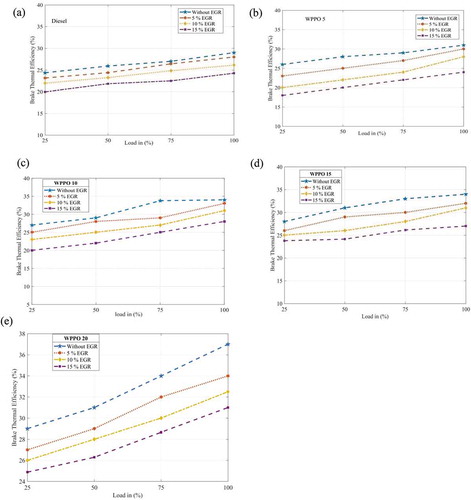
shows the alteration of BTE with respect to the engine load and EGR percentages for the WPPO biodiesel blends HCCI mode and comparison with the diesel HCCI operation. From the figure, it is observed that the increasing EGR proportions decreases the brake thermal efficiency. As EGR proportions increases rate of combustion decreases, which causes lower in-cylinder temperature [30]. At the WPPO 5%, 10%, 15% and 20% of different blends are similar brake thermal efficiency up to 50% load conditions but it reached to 75% and 100% load conditions higher efficiency compare with neat diesel fuel but, the optimum blend WPPO 20 % given the high brake thermal efficiency at the 25% and 100% load conditions which account of 17.24% and 23.68% increased compare with the diesel fuel (Bendu and Sivalingam Citation2016).The short combustion leads to better mixture homogeneity and resulting into less soot formation. The lower BTE is found for the initial stage loads because the retarded start of combustion in HCCI engine the heat losses are lower because LTC. The higher combustion temperatures and high Rate of Heat Release (RoHR) are affected by the advance SoC. Meanwhile retarding the SoC results in less combustion efficiency because increased emissions and lower LTC.
6.2. Exhaust gas temperature (EGT)
Figure 11. (a–e) EGT of diesel and waste plastic pyrolysis oil biodiesel HCCI combustion at various load and EGR conditions.
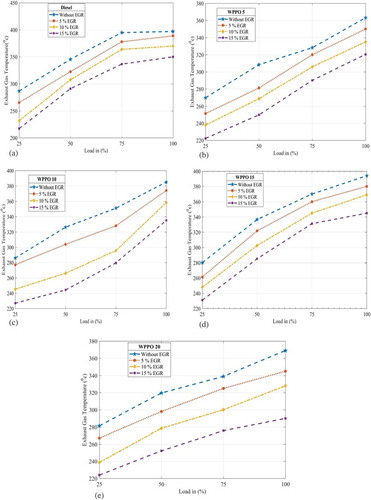
The variation of EGT of tested fuels under various loads and without EGR and with 5%,10% and 15% EGR for the WPPO biodiesel blends HCCI mode and as compared with the diesel HCCI operation is shown in . From the figure, it is noticed that the exhaust gas temperature is found to be lower by 17.14 % without EGR and 27 % with 15 % EGR as compared with diesel fuel. The cause for reduction in exhaust gas temperature is that the general air-fuel mixture is lean; which outcomes in lower combustion temperature. Due to the start of combustion are advanced because the faster reaction rates and chemical kinetics. A shortly SoC with the short combustion time effects high convective heat transfer. This in turn increases the burned hot gases residence time within the cylinder causes reduction in the EGT (Agarwal et al. Citation2013).
7. Emissions characteristics
7.1. NOx emission
Figure 12. (a–e) NOx emissions of diesel and waste plastic pyrolysis oil biodiesel HCCI combustion at varying load and EGR percentages.
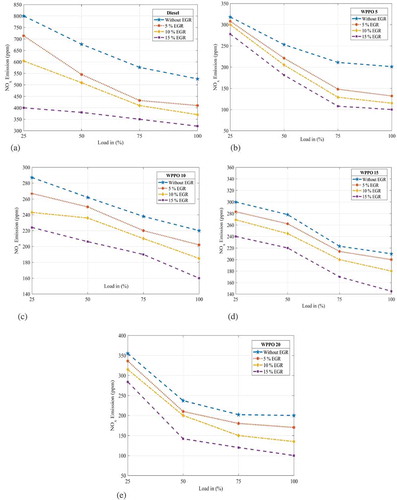
shows the effect of load and EGR proportion on NOx emission for the WPPO biodiesel blends HCCI operation and compared with the diesel HCCI operation. It is cleared that the NOx emission decreases with increasing the load, without EGR and with 5%,10%,15% EGR simultaneously, the WPPO 5%, 10% 15% and 20% at full load conditions which account of 50 %, 52%, 55.62% and 65%. From the figure, it is cleared that the NOx emission is found to be lower by 50% without EGR and 65 % with 15 % EGR as compared with diesel fuel. Due to increase exhaust gas is recycled to the intake for control of NOx emissions and also homogenisation of the combustion, lower peak in-cylinder temperature but drastically decreases in NOx emission with 15% EGR.
7.2. Carbon monoxide (CO) emission
Figure 13. (a–e) CO emissions of diesel and waste plastic pyrolysis oil biodiesel HCCI combustion at varying load and EGR percentages.
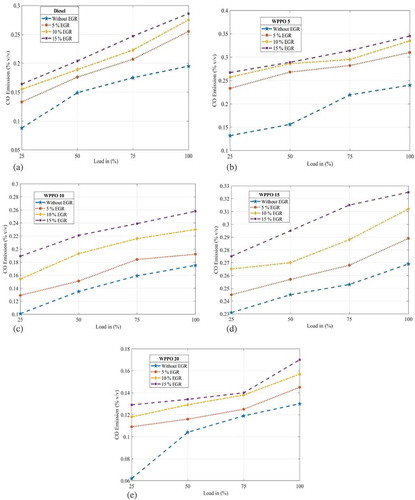
shows the effect of load and EGR percentages on carbon monoxide for the WPPO biodiesel blends HCCI operation and as compared with the diesel HCCI operation. From the figure, it is found that the increasing the load and EGR percentages increase the carbon monoxide level simultaneously, the WPPO 5 % and 15 % at full load condition onwards gives 0.34 % and 0.325 % high carbon monoxide (CO) level when compare with neat diesel fuel. At the WPPO 10 % and 20 % blends are 0.29 % and 0.54 % less carbon monoxide (CO) level from 25 % stage to full load conditions when compare with neat diesel fuel. Due to Low temperature combustion (LTC) is causes by the insufficient oxidation temperature of the gases, which results in the formation of CO emissions in the HCCI engine. The increase in the CO emission is found with increase engine load and EGR percentages because decrease in the peak cylinder temperature. The lower CO emission is because advanced SoC while high CO emission is because late combustion staging (Bendu and Sivalingam Citation2016).
7.3. Unburnt hydrocarbon (UHC) emission
Figure 14. (a–e) UHC emissions of diesel and waste plastic pyrolysis oil biodiesel HCCI combustion at different load and EGR percentages.

shows the variation of unburned hydrocarbons (UHC) of various fuels under different loads and EGR conditions for the WPPO biodiesel blends HCCI operation and as compared with the diesel HCCI operation. From the figure, it can be stated that the increasing the load and EGR percentages increase the unburnt hydrocarbons level simultaneously, the WPPO 5 %, 15 % and 20 % at full load condition at 15 % EGR onwards gives 18.92 %, 21.20 % and 28.09 % reduce UHC emission level when compare with neat diesel fuel, whereas at the WPPO 10 % blend is at full load condition it is found 2.15 % high UHC level when compare with neat diesel fuel. The incomplete combustion of hydrocarbon fuel is indicated by formation of UHC emissions in the HCCI engine because a LTC. The combustion temperature is much lower near the walls of combustion chamber because heat losses. Superior parts of UHC emissions rises from the combustion chamber regions. EGR also affects UHC emissions in HCCI mode due to with increasing EGR, response rate diminishes in light of the fact that nearness of non-reactive exhausts species inside the ignition chamber. These species helps UHC arrangement by bringing down the in-cylinder temperature (Singh and Agarwal Citation2012).
7.4. Smoke opacity
Figure 15. (a–e) Smoke opacity of diesel and waste plastic pyrolysis oil biodiesel HCCI combustion at different load and EGR conditions.
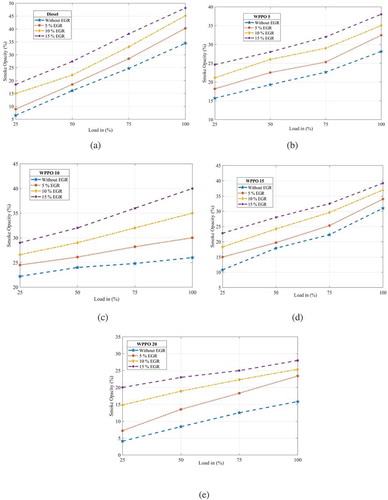
shows the variation of the smoke opacity with load and EGR percentage for the WPPO biodiesel blends HCCI operation and as compared with the diesel HCCI operation. From the figure, it is noticed that the increasing load and without EGR, with 5 %, 10% and 15 % EGR decrease the smoke opacity level by 18 % without EGR and 28 % with 15 % EGR as compared with neat diesel fuel. Due to the absence of diffusion combustion and limited fuel rich blend debilitate the arrangement of smoke emission (Ganesh, Nagarajan, and Ganesan Citation2014).
8. Conclusion
WPPO biodiesel blended and diesel used effectively for the HCCI (PFI with fuel vaporiser) and results were analysed which are presented as follows
Because larger deposition of plastic wastes in the earth surface pyrolysis process shows better conversion of plastics in to useful hydro carbon fuels like petrol, diesel. On efficiently doing this process the production cost per litre fuel decreases as compared with crude oil refining. Because increased fuels demand this process illustrations an alternative way of producing fuel which can able to meet the global fuel demand.
In HCCI, two-stage heat release has been observed. Low temperature combustion chemistry is causes to first-stage combustion, but high temperature combustion controls the second stage combustion. Chemical kinetics of WPPO bio-diesel HCCI was found to be faster as compared with diesel HCCI. The impact of EGR has been investigated and concluded that EGR is the best method to control HCCI engine.
Higher Brake thermal efficiency was found 37 % without EGR at WPPO 20 % biodiesel blend.
A significant reduction in NOx emission is found up to 65 % with using WPPO 20 % with 15% EGR.
The carbon monoxide and unburned hydrocarbons emission were much higher for HCCI engine than diesel engine. The biodiesel fuelled HCCI engine has lower CO emission because higher oxygen molecule present in the cylinder during the combustion process. The level of CO and UHC emissions were increased with engine load and exhaust gas is recycled to the intake.
A maximum increase of UHC is noticed in WPPO 10 % biodiesel. Among the all test fuels using WPPO 5%, 15% and 20% observed the lowest UHC emission.
A maximum increase of CO is found in WPPO 5 % and 15 % biodiesel. Among the all test fuels using WPPO 10% and 20% stated the lowest CO emission.
A reduction in smoke opacity up to 28 % with using WPPO 20%.
HCCI limited by the operating regime. Combustion noise limited by the higher load and the CO and UHC emissions are limited by the lower load.
By using Low Temperature Combustion method that is HCCI operated with biodiesel has advantageous with respect to engine performance and combustion as compared with conventional engine.
Notations
| HCCI | = | Homogeneous charge compression ignition |
| LTC | = | Low-temperature combustion |
| HTR | = | High-temperature reduction |
| LTR | = | Low-temperature reduction |
| PFI | = | Port fuel injection |
| SoC | = | Start of combustion |
| WPPO | = | Waste plastic pyrolysis oil |
| BTE | = | Brake thermal efficiency (%) |
| EGT | = | Exhaust gas temperature (°c) |
| ATDC | = | After top dead centre |
| BTDC | = | Before top dead centre |
| RoHR | = | Rate of heat release |
| RoPR | = | Rate of pressure rise |
| CAD | = | Crank angle degree |
| EGR | = | Exhaust gas recirculation |
| NOx | = | Oxides of nitrogen |
| ppm | = | part per millions |
| CO | = | Carbon monoxide |
| UHC | = | Unburnt hydrocarbons |
Future scope of the work
HCCI with PFI and vaporiser can be studied using other biodiesels.
Investigates by changing the intake charge temperature, compression ratio.
Studies on multi-cylinder engines using PFI and vaporiser systems.
Acknowledgments
This study is supported by the Department of Mechanical Engineering, RGMCET, Nandyal, India. The authors wish to thank, the Lab in charge prof. K. Thirupathi Reddy for their help during the test rig in development and experimental in the Internal Combustion Research Engines Lab of RGMCET, Nandyal, India.
Disclosure statement
No potential conflict of interest was reported by the authors.
Additional information
Notes on contributors
Jyothunaik Ramavathu
Jyothunaik Ramavathu received his M.Tech degree in Mechanical Engineering from JNTU Kakinada, India in 2012. Currently he is a Ph.D. scholar of JNTU Anantapur in Mechanical Engineering since 2017. He worked as Assistant Professor for 4 years. He is carrying out research work in the field of HCCI engines. His research interests include alternative fuels, emission control and LTC.
Thirupathi Reddy Kota
Thirupathi Reddy Kota, Professor and Head in the Department of Mechanical Engineering, Rajeev Gandhi Memorial college of Engineering and Technology, Nandyal, India. He received his Doctor of Philosophy from JNTU Hyderabad. He guided around 4 Ph.D scholars under his supervisions. The author has published around 50 international journals. His areas of interest include, Internal combustion engines, HCCI, alternative fuels, emission control and LTC.
References
- Agarwal, A. K., A. P. Singh, J. Lukose, and T. Gupta. 2013. “Characterization of Exhaust Particulates from Diesel Fueled Homogenous Charge Compression Ignition Combustion Engine.” Journal of Aerosol Science 58: 71–85. doi:10.1016/j.jaerosci.2012.12.005.
- Antony., R., and M. Advaith. 2011. “Conversion of Plastic Wastes into Fuels.” Journal of Materials Science and Engineering B 1 (1): 86–89.
- Bendu, H., and S. Murugan. 2014. “Homogeneous Charge Compression Ignition (HCCI) Combustion: Mixture Preparation and Control Strategies in Diesel Engines.” Renewable and Sustainable Energy Reviews 38: 732–746. doi:10.1016/j.rser.2014.07.019.
- Bendu, H., and M. Sivalingam. 2016. “Experimental Investigation on the Effect of Charge Temperature on Ethanol Fueled HCCI Combustion Engine.” Journal of Mechanical Science and Technology 30 (10): 4791–4799. doi:10.1007/s12206-016-0951-6.
- Deepak, C. 2018. “Khuda Dhan.” test book.
- Gadwal, S. B., N. R. Banapurmath, M. A. Kamoji, P. B. Rampure, and S. V. Khandal. 2018. “Performance and Emission Characteristic Studies on CRDI Diesel Engine Fuelled with Plastic Pyrolysis Oil Blended with Ethanol and Diesel.” International Journal of Sustainable Engineering 12 (4): 1–10.
- Ganesh, D., and G. Nagarajan. 2010. “Homogeneous Charge Compression Ignition (HCCI) Combustion of Diesel Fuel with External Mixture Formation.” Energy 35 (1): 148–157. doi:10.1016/j.energy.2009.09.005.
- Ganesh, D., G. Nagarajan, and S. Ganesan. 2014. “Experimental Investigation of Homogeneous Charge Compression Ignition Combustion of Biodiesel Fuel with External Mixture Formation in a CI Engine.” Environmental Science & Technology 48 (5): 3039–3046. doi:10.1021/es403104f.
- Ganesh, D., G. Nagarajan, and M. M. Ibrahim. 2008. “Study of Performance, Combustion and Emission Characteristics of Diesel Homogeneous Charge Compression Ignition (HCCI) Combustion with External Mixture Formation.” Fuel 87 (17–18): 3497–3503. doi:10.1016/j.fuel.2008.06.010.
- Gray III, A. W., and T. W. Ryan III. 1997. “Homogeneous Charge Compression Ignition (HCCI) of Diesel Fuel.” SAE Transactions 971676: 1927–1935.
- Hasegawa, R., and H. Yanagihara. 2003. “HCCI Combustion in DI Diesel Engine.” SAE Transactions 1 (745): 1070–1077.
- Hassan, H., J. K. Lim, and B. H. Hameed. 2016. “Recent Progress on Biomass Co-pyrolysis Conversion into High-quality Bio-oil.” Bioresource Technology 221: 645–655. doi:10.1016/j.biortech.2016.09.026.
- Jyothu Naik, R., and K. Thirupathi Reddy. 2018. “A Review on Diesel Homogeneous Charge Compression Ignition Engine.” Academia Journal of Scientific Research 6 (8): 321–328.
- Kaminsky, W., B. Schlesselmann, and C. Simon. 1995. “Olefins from Polyolefins and Mixed Plastics by Pyrolysis.” Journal of Analytical and Applied Pyrolysis 32: 19–27. doi:10.1016/0165-2370(94)00830-T.
- Lopez, A., I. De Marco, B. M. Caballero, M. F. Laresgoiti, and A. Adrados. 2011. “Influence of Time and Temperature on Pyrolysis of Plastic Wastes in a Semi-batch Reactor.” Chemical Engineering Journal 173 (1): 62–71. doi:10.1016/j.cej.2011.07.037.
- Midlam-Mohler, S., G. Rizzoni, M. Bargende, and S. Haas. 2003. Mixed-mode Diesel HCCI with External Mixture Formation: Preliminary Results. Newport: Ohio State University Center for Automotive Research Michael Bargende, Simon Haas FKFS, Universität Stuttgart.
- Milovanovic, N., R. Chen, R. Dowden, and J. Turner. 2004. “An Investigation of Using Various Diesel-type Fuels in Homogeneous Charge Compression Ignition Engines and Their Effects on Operational and Controlling Issues.” International Journal of Engine Research 5 (4): 297–316. doi:10.1243/146808704323224213.
- Murugan, S., M. C. Ramaswamy, and G. Nagarajan. 2009. “Assessment of Pyrolysis Oil as an Energy Source for Diesel Engines.” Fuel Processing Technology 90 (1): 67–74. doi:10.1016/j.fuproc.2008.07.017.
- Ryan, T. W., and T. J. Callahan. 1996. “Homogeneous Charge Compression Ignition of Diesel Fuel (no. 961160).” SAE Technical Paper. 157–166.
- Sartorius, I. 2010. Materials Case Study 4: Plastics. Mechelen, Belgium: OECD Global Forum on Environment.
- Saxena, S., S. Schneider, S. Aceves, and R. Dibble. 2012. “Wet Ethanol in HCCI Engines with Exhaust Heat Recovery to Improve the Energy Balance of Ethanol Fuels.” Applied Energy 98: 448–457. doi:10.1016/j.apenergy.2012.04.007.
- Sharuddin, S. D. A., F. Abnisa, W. M. A. W. Daud, and M. K. Aroua. 2017. “Energy Recovery from Pyrolysis of Plastic Waste: Study on Non-recycled Plastics (NRP) Data as the Real Measure of Plastic Waste.” Energy Conversion and Management 148: 925–934. doi:10.1016/j.enconman.2017.06.046.
- Singh, A. P., and A. K. Agarwal. 2012. “Combustion Characteristics of Diesel HCCI Engine: An Experimental Investigation Using External Mixture Formation Technique.” Applied Energy 99: 116–125. doi:10.1016/j.apenergy.2012.03.060.
- Thipse, S. S. 2008. Internal Combustion Engines. New Delhi: Jaico Publishing Book.
- Vu, P. H., O. Nishida, H. Fujita, W. Harano, N. Toyoshima, and M. Iteya. 2001. “Reduction of NOx and PM from Diesel Engines by WPD Emulsified Fuel (no. 2001-01-0152).” SAE Technical Paper.
- Williams, E. A., and P. T. Williams. 1997. “The Pyrolysis of Individual Plastics and a Plastic Mixture in a Fixed Bed Reactor. Journal of Chemical Technology & Biotechnology: International Research in Process.” Environmental AND Clean Technology 70 (1): 9–20.
- Wong, S. L., N. Ngadi, T. A. T. Abdullah, and I. M. Inuwa. 2015. “Current State and Future Prospects of Plastic Waste as Source of Fuel: A Review. Renewable and Sustainable Energy.” reviews 50: 1167–1180.
- Zhen, X., and Y. Wang. 2015. “Numerical Analysis of Knock during HCCI in a High Compression Ratio Methanol Engine Based on LES with Detailed Chemical Kinetics.” Energy Conversion and Management 96: 188–196. doi:10.1016/j.enconman.2015.02.053.



